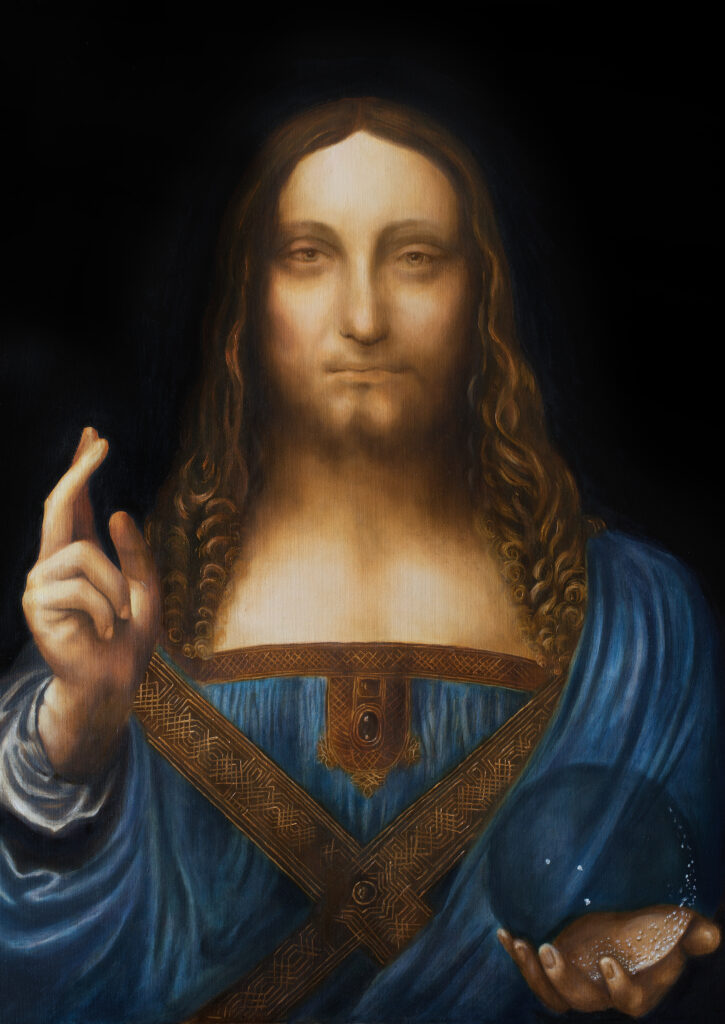The infamous Salvator Mundi (translated from Latin: Savior of the World) painting is among one of the fewer than 20 completed works attributed to famed Italian Renaissance artist, Leonardo da Vinci.
Art appreciators are captivated by the non-refracting crystal sphere held in Jesus’ left hand, however, it is the same feature which emboldens art historians to question whether da Vinci is the original artist and doubting its authenticity.

Salvator Mundi also holds the distinction of being the most expensive painting to be sold at private auction.
Humble Beginnings
Salvator Mundi is a 26-inch oil painting that features Leonardo da Vinci’s interpretation of Jesus Christ as the Savior of the world according to descriptions outlined in the book of John in the Bible.
Jesus is painted pronouncing the benediction with his right hand and holding a transparent crystal orb – representing the created universe – in his left, indeed signaling his responsibility of saving humanity.
Originally thought to have been commissioned by King Louis XII following the Milan and Genoa conquests circa 1500, the painting was assumed to have been destroyed.
The painting is presumed to have changed several hands in the intervening years, and along the way, several copies were made either by students of da Vinci or other enthusiastic followers.
It also made its sojourn from Italy to the Netherlands to Belgium and finally to the United Kingdom, being owned by royalty and other noblemen throughout its history.
A follower of da Vinci, Bernardino Luini, floated the piece as one of his own in 1900 after 137 years of absence from public view and after a failed restoration attempt had damaged some of its key features.
It was then purchased by a British collector whose relative later sold it at a Sotheby’s auction several decades later as a piece attributed to yet another pupil of da Vinci’s, Giovanni Antonio Boltraffio, who held the honor until 2011.
At the time of this auction in 1958, the painting fetched £45 – about $125 at that time.
Resurface, Restoration and Sale
Robert Simon and his two business partners, passionate about da Vinci, bought the piece at a Louisiana auction for under $10,000.
Although they had doubts about its origin and authenticity, they soon decided it was worth researching and eventually arranged its careful restoration.
The painting was authenticated at the National Gallery in London in 2008 after being recognized as one of Da Vinci’s lost masterpieces three years earlier.
In bolstering their claims of an original da Vinci work, art scholars posited that the finding was “the greatest artistic rediscovery of the 20th century.”
Three years after its authentication, the painting was unveiled to the public for the first time in its restored state at a da Vinci exhibition.
By 2013 Salvator Mundi changed hands anew, winding up with a Russian art collector in a sale facilitated by Sotheby’s where he acquired the painting for $125 million.
The Russian art collector went on to sell the painting further for an undisclosed sum and the piece made an exhibition tour in Hong Kong and three US cities before being put up for auction once more.
Though offers started at $100 million when the auction opened in 2017, the awe-inspiring work of art eventually sold for $450 million at Christie’s in New York.
The painting was reportedly purchased by a member of the Saudi royal family, Badr bin Abdullah bin Mohammed bin Farhan al Saud, although the true owner has not been verified.
Controversy
Salvator Mundi is one of the most copied paintings of da Vinci’s with about 12 known copies painted by his students or followers.
The origin of the painting is shrouded in mystery with questions around whether Leonardo Da Vinci actually painted it or whether he only contributed certain elements.
Scientists, Renaissance art experts, and art enthusiasts alike have varying and opposing viewpoints about whether the attention-grabbing orb which is depicted on the right side of the painting holds any realism.
To lend credence to their critique, art historians point out that da Vinci himself was a scholar, who at the time was studying the very subject of how the eyes focus so he would not have deigned to paint something as unrealistic as a non-refracting crystal.
Added to this, owing to the vast restoration work, necessary to restore the painting to its former glory and further over-painting, experts hold that there is hardly anything remaining of the original work, thus diluting its value.
The painting was also mired in controversy owing to a lawsuit that was filed by Russian art collector, Dmitri Rybolovlev against Sotheby’s and a Swiss art dealer, who were accused of collusion to defraud the collector during the sale.
Today, Salvator Mundi remains the last piece of da Vinci’s work that was owned by a private individual.
